Effective sales enablement doesn’t require a big budget or a large team. In fact, aligning your SMB is easier than you might think.
In this post, you’ll learn how to create a five-step sales enablement strategy that helps you close more deals with less effort. You’ll also get tips on hiring the right sales enablement manager for your company.
What is sales enablement?
Sales enablement involves creating and gathering content and tools that help your company sell products effectively.
These resources include pitch decks, how-to guides, onboarding documents, sales training cheat sheets, digital tools and more.
For example, Pipedrive’s website features case studies that explain how real-world companies use its customer relationship management (CRM) platform:

The sales team can search keywords and send specific links to companies that want to see how others have successfully improved win rates and shortened buying cycles.
Usually, marketing and sales create a mix of internal and customer-facing assets to move leads closer to a purchase.
Typical types of assets include:
Content marketing efforts (e.g., case studies, one-pagers, pitch decks and email templates)
Internal tools (e.g., sales playbooks, demo scripts and FAQ sheets)
Training and coaching resources (e.g., recorded calls, roleplay scenarios and quick tips)
You don’t need to create all of these assets at once. Many SMBs start with a few core items (like a playbook, case study and a one-pager) and build from there.
Let’s say one of your reps finishes a sales demo with an interested prospect. On the call, the prospect asked how similar companies use your product and how they’d integrate it into their systems.
With a sales enablement strategy, salespeople can access a shared knowledge base full of marketing content.
Within five minutes, the rep can pull three or four relevant case studies and email them, along with a PDF explaining how to integrate the product using an API.
What are the data-backed benefits of sales enablement?
Creating a structured sales enablement strategy improves customer experience (CX) and drives real business results.
SMBs use the strategy to close deals faster, offer consistent messaging and make the most of limited resources.
Here are three of the top data-backed benefits.
1. Faster deal cycles
Sales enablement streamlines access to content, tools and data so reps can respond faster and keep deals moving.
Speed is everything for lean SMB teams, and the right technology makes that speed possible. According to recent Highspot research, 72% of executives agree that AI-powered enablement improves performance and sales productivity.
Let’s say a small software company uses AI to analyze buyer personas and create personalized sales pitches.
Reps spend less time digging for relevant materials, and buyers get what they need faster to make quicker decisions. This technology cuts the average sales cycle duration from 30 to 18 days.
2. Higher win rates
When all sales materials, training and insights live in one place, reps stay aligned and focused on what works.
That consistency means fewer missed opportunities and more repeatable success. According to Highspot’s research, companies using a unified sales enablement platform are 80% more likely to increase win rates.
Imagine a logistics firm rolls out a centralized content management system (CMS). As all reps now refer to the same top-performing messaging, prospects hear clearer, more consistent value propositions across the board.
That consistency builds trust and reduces confusion, so buyers feel more confident and close rates increase by 15% in a quarter.
3. Consistent sales performance
Sales enablement ensures that new and experienced reps follow proven playbooks and get continual training.
When onboarding is faster, sales professionals will hit their stride sooner. The study cited above shows that data-driven sales enablement training (which uses real performance metrics like call outcomes or content usage to tailor coaching) makes companies 36% more likely to decrease sales rep ramp-up time.
For example, say a cybersecurity startup cuts new hire onboarding from 90 to 60 days by giving reps access to recorded calls, objection-handling guides and live shadowing tools. These strategic materials streamline the learning process and build competence quickly.
How to create a sales enablement strategy: 5 best practices
Effective sales enablement relies on giving your team every tool and asset they need to close a deal.
There’s no one-size-fits-all approach to developing a strategy. It’ll look different depending on your product, company and industry. However, there are some common steps every brand can follow.
Here are five sales enablement best practices to create a formula that drives more sales.
1. Audit your current sales funnel
Before you improve your sales enablement, it’s important to understand what’s working and what’s not across your funnel. A quick audit helps you spot gaps, remove friction and focus your efforts.
At the heart of every sales enablement strategy is optimizing your customer journey – the buying process people go through (from discovery to retention) when interacting with your brand.
Most companies split the customer journey into three stages of a marketing funnel: awareness (top of funnel), consideration (middle of funnel) and decision (bottom of funnel).
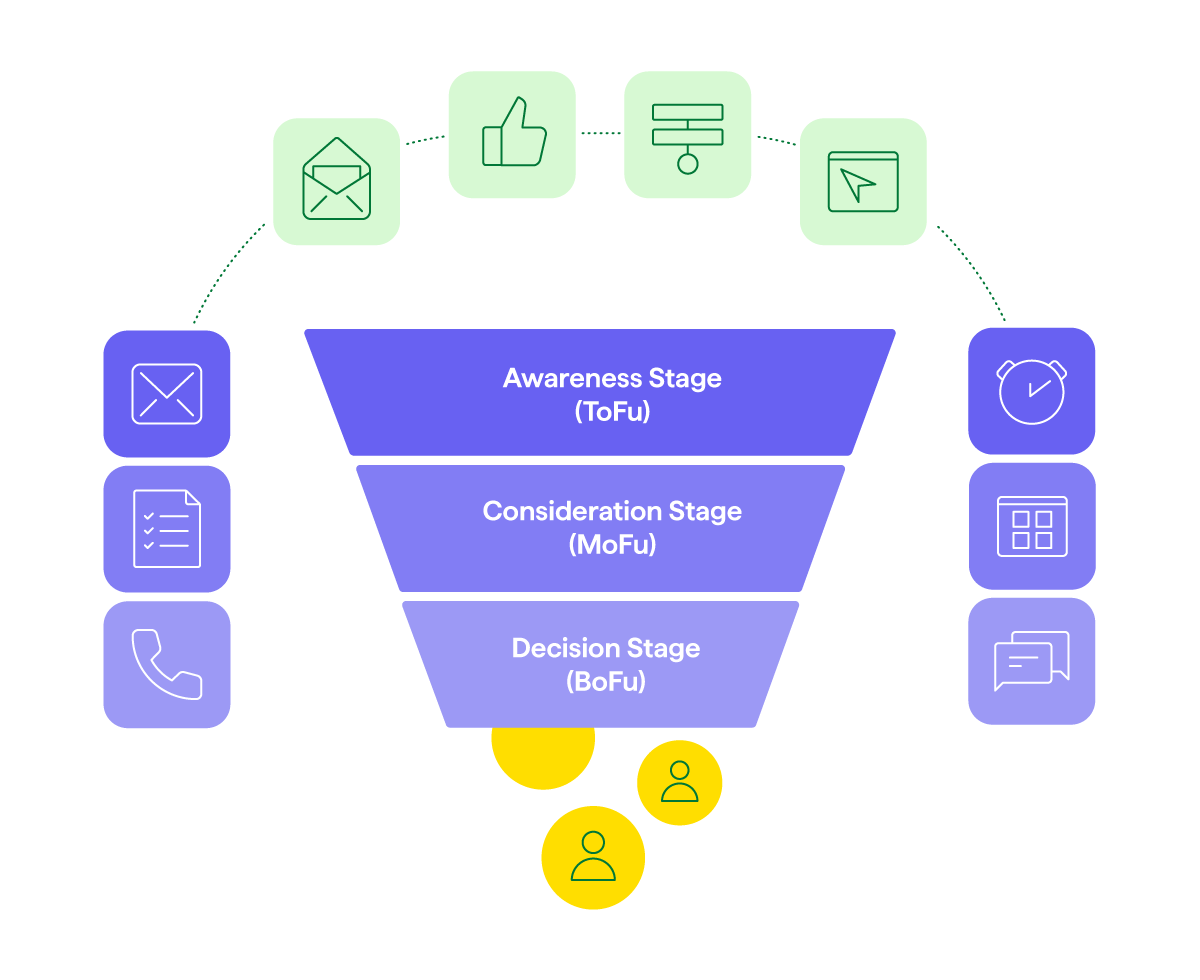
By analyzing what resources your team has, you’ll get a better understanding of what sales tools or content your enablement efforts need at each stage.
For example, you may be tracking deals in a spreadsheet. Adding a robust CRM platform to your tech stack centralizes sales data, improves visibility and helps reps prioritize the right opportunities:
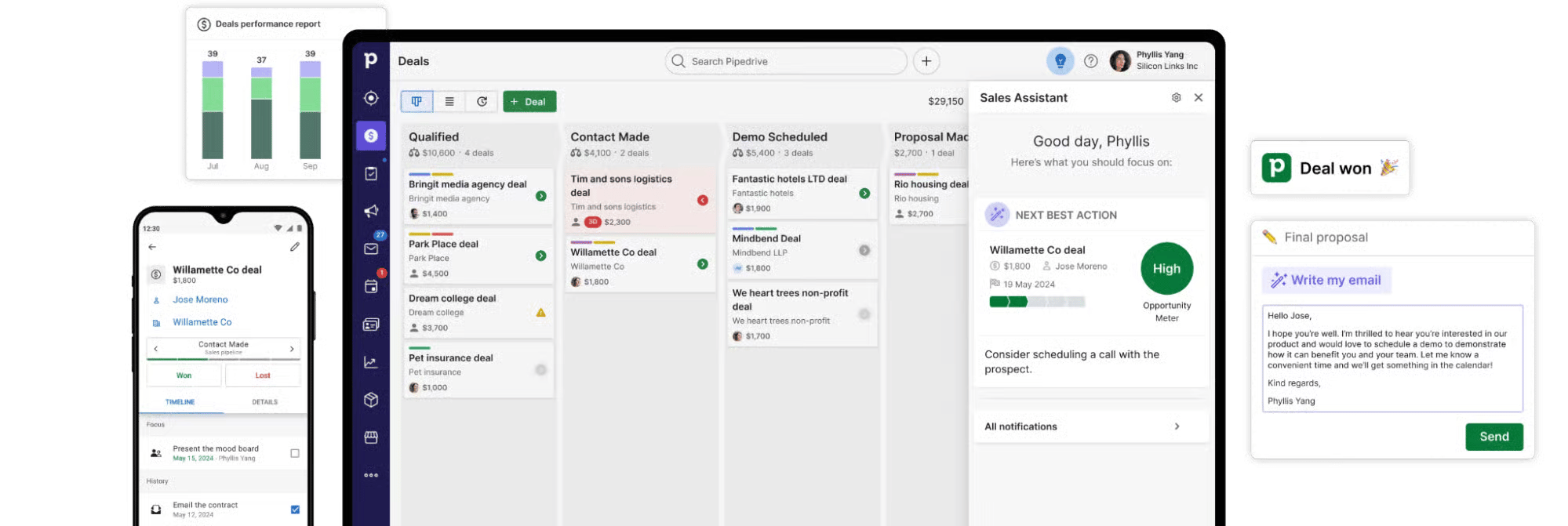
Audit your entire buyer’s journey and sales funnel to identify weak points. For example, if your team is booking enough demos but your close rate is low, you need to find out why.
A low close rate may indicate a lack of assets, insufficient training or lackluster demos.
To audit your own sales funnel, follow these steps:
Map your full funnel. Outline each stage from lead generation to closed deals. Use your CRM or even a whiteboard to visualize the journey.
Review customer conversions at each stage. Identify where leads are dropping off or deals are stalling.
Evaluate current content and tools. Note the assets reps use at each stage and if they’re relevant, up-to-date and easy to find.
Talk to your sales team. Ask what slows them down, what content they rely on and where they feel unsupported.
Look at onboarding and training. Work out how long it takes for new reps to ramp up and if they follow a consistent sales enablement process.
Check for tech gaps or silos. Create a plan for integrating systems. Multiple disconnected tools slow things down.
Analyze top-performing reps. Find out what they’re doing differently and what you can standardize across the team.
A funnel audit gives you a clear picture of what to fix, optimize or support with better enablement tools and content.
2. Align sales and marketing teams
When your sales and marketing teams share goals, messaging and feedback, you’ll move leads through the funnel more effectively.
Alignment ensures every effort supports revenue, so you create impactful content and spend time and resources on the right prospects.
According to Pipedrive’s 2024 State of Sales and Marketing Report, one in three sales teams is investing more in aligning sales and marketing.
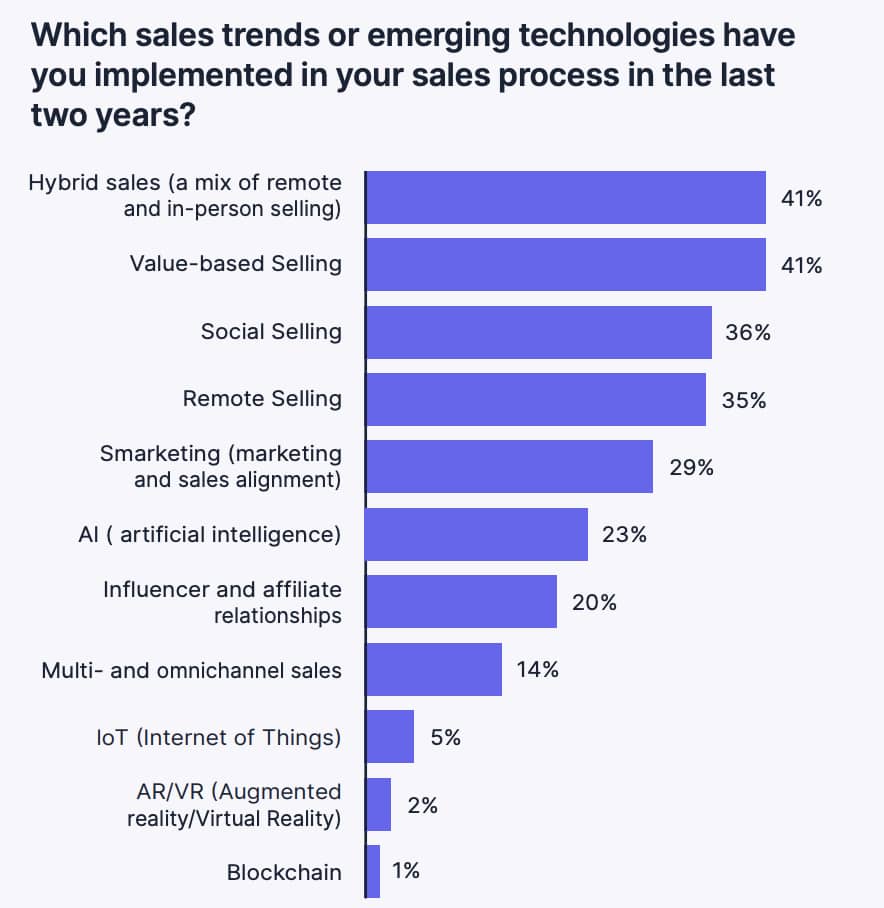
Both teams can benefit from each other’s insights. Marketing can use sales data to decide which assets to develop next, while that content helps reps win over potential customers.
Say your marketers regularly check in with sales and learn reps need more bottom-of-funnel (BOFU) content. By creating new case studies and demo videos, the marketing team provides materials that help purchases spike.
The handoff between teams also runs more smoothly. Marketing qualified leads (MQLs) are better informed and more confident because the content they’ve seen speaks directly to their needs.
Sales reps can then seamlessly pick up the conversation, using the same language and stories potential buyers have already engaged with.
Here’s how to align both departments:
Define shared goals. Ensure both teams are aiming for the same outcomes (e.g., qualified leads or revenue targets).
Agree on lead definitions. To avoid confusion, clarify what makes a lead “marketing-qualified” or “sales-ready”.
Set up regular check-ins. Weekly or bi-weekly syncs help surface feedback, content gaps and campaign ideas.
Create a shared content hub. Store decks, case studies, templates and messaging guides in one central place.
Use feedback loops. Sales must share what content drives purchases, while marketing improves based on real buyer conversations.
Celebrate wins together. Recognize when a coordinated effort leads to a closed deal or strong campaign.
When sales and marketing move in sync, messaging stays consistent and you make better use of every resource. Even one regular meeting or shared doc can make a big difference.
Download Your Sales and Marketing Strategy Guide
3. Create buyer-centric content
Create content that speaks directly to your customer’s pain points, goals and objections at each sales funnel stage.
With limited time and budget, every piece of content needs to pull its weight. Buyer-centric content shortens sales cycles, builds trust and gives reps what they need to move deals forward.
Picture an HR tech company that notices potential customers keep asking about data security. By creating a simple one-pager answering common questions, sales can address these concerns up front and move prospects to the demo stage faster.
Here are some typical types of sales enablement content and why it’s effective:
Type of sales enablement content | Why it works |
One-pager | Quickly explains your product or service, key benefits and use cases. Example: A SaaS company creates a one-pager outlining integrations and time-saving features for mid-funnel buyers comparing options. |
Case study | Builds trust by showing real customer success stories. Example: An IT services firm shares a case study about helping a hospital cut system downtime by 40%, giving reps proof points during sales calls. |
Demo video | Lets buyers see the product in action, even before a live demo. Example: A manufacturing company sends a three-minute demo video to prospects who want a quick look before booking a call. |
Battlecard | Equips reps to handle objections and position against competitors. Example: A startup selling HR tools creates a battle card comparing its key features to a top competitor’s for late-stage calls. |
Email template | Speeds up outreach and follow-ups with clear, tested messaging. Example: A logistics firm gives reps email templates for cold outreach, post-demo follow-ups and pricing discussions. |
Incorporate any relevant content your marketing team generates that helps answer a question or reinforce value during sales conversations.
Here’s how to create the right type of content to convert your buyers:
Survey your sales team. Find out what questions buyers ask, where they get stuck and what content reps wish they had.
Map content to the funnel. Make sure you have the right mix of awareness (e.g., blog posts), consideration (e.g., case studies) and decision-stage content (e.g., ROI calculators).
Focus on real problems. Address the pain points your buyers care about, not just what you want to sell.
Use buyer language. Mirror the words and phrases your audience uses in conversations or emails.
Test and refine. Track which content each team uses to close deals and update based on what’s working.
Creating content that answers real questions and clears up doubts empowers your reps and builds trust with prospects at every step.
4. Equip your team with the right sales enablement software
Sales enablement technology helps your team organize content, track deals and automate repetitive tasks. With everything under one roof, reps can spend more time selling and less time searching or updating spreadsheets.
For example, a CRM like Pipedrive gives you structure without complexity. You can easily scale your efforts and use reports to gain visibility into the parts of your sales strategy that are working.
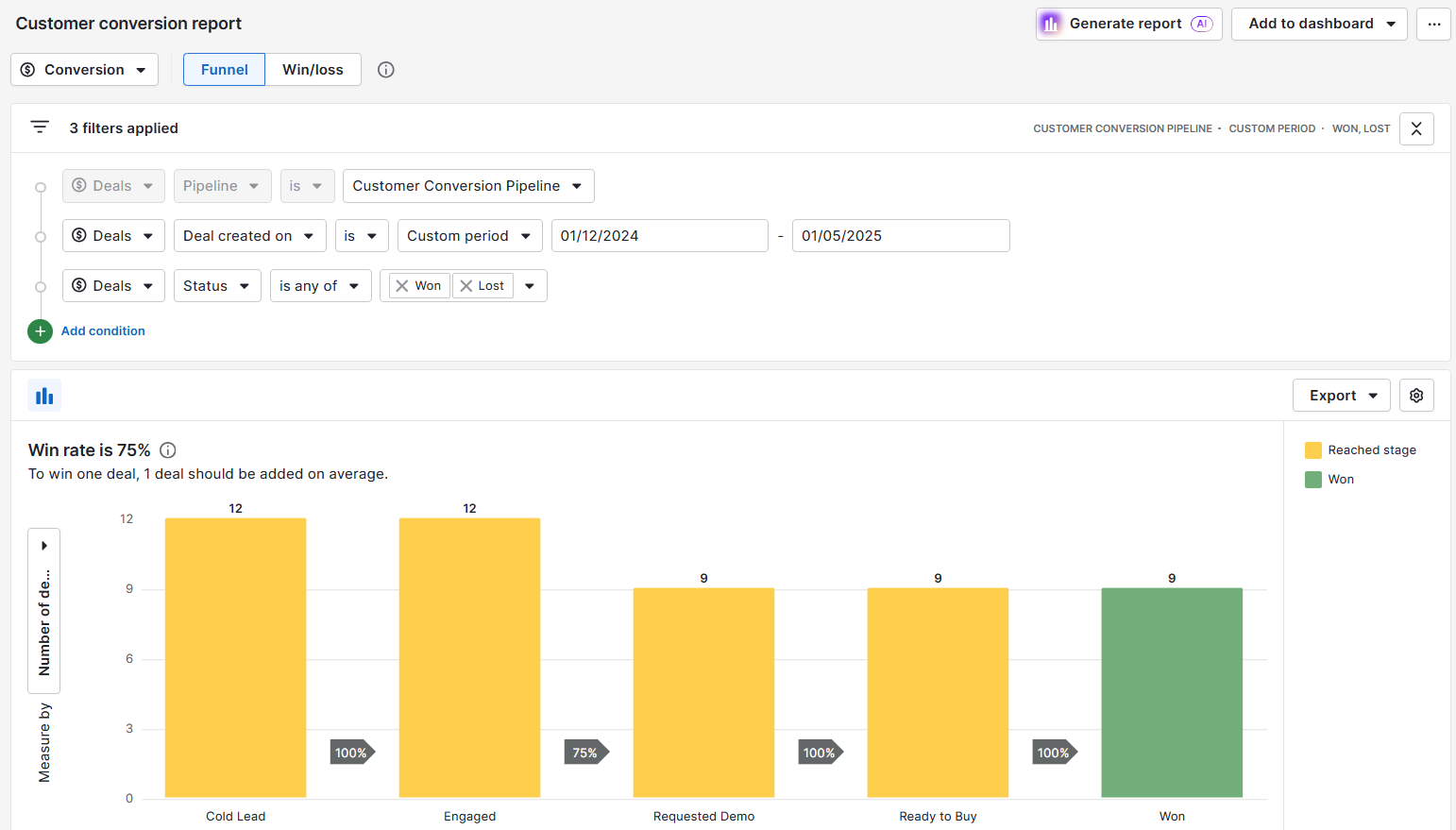
You can make sales enablement more actionable without overwhelming your team by using your CRM system to:
Build your sales pipeline. Set up deal stages that reflect your actual sales process (e.g., “Qualified > Demo > Proposal > Closed”).
Add custom fields. Capture the details that matter most to your business, like lead source or industry.
Centralize content. Upload one-pagers, case studies and templates so reps can easily access what they need.
Automate follow-ups. Use workflow automation to trigger reminders, emails or task assignments at the right time based on deal movement.
Integrate tools. Use integrations to connect your email, calendar apps and marketing tools so everything lives in one place.
A tool like Pipedrive also includes built-in sales reporting dashboards to help you monitor pipeline health, rep activity and conversion rates.
Tracking the right key performance indicators (KPIs) gives you insight into how your team is performing and where to improve. Look at real-time metrics like:
Average deal size
Sales cycle length
Lead-to-opportunity conversion rate
Opportunity-to-close rate
Sales rep activity (e.g., emails sent, calls made, follow-ups)
Marketing and sales content usage (i.e., which assets are helping close deals)
Sales enablement tools remove friction and give your team a repeatable, data-driven way to sell. The right software lets you move fast, stay organized and enable sales every day.
5. Train and coach reps continuously
Ongoing sales coaching and training ensure rep performance improves over time. It’s about reinforcing what works, sharpening skills and adapting to changing buyer needs.
In a small team, one top-performing rep can make a huge impact. Consistent sales training ensures they don’t plateau. It also helps other team members learn from successful tactics.
According to RAIN research, salespeople with effective managers and regular coaching are 63% more likely to be top performers.
Imagine a cybersecurity firm reviews its CRM data and notices one rep consistently closes faster than the rest.
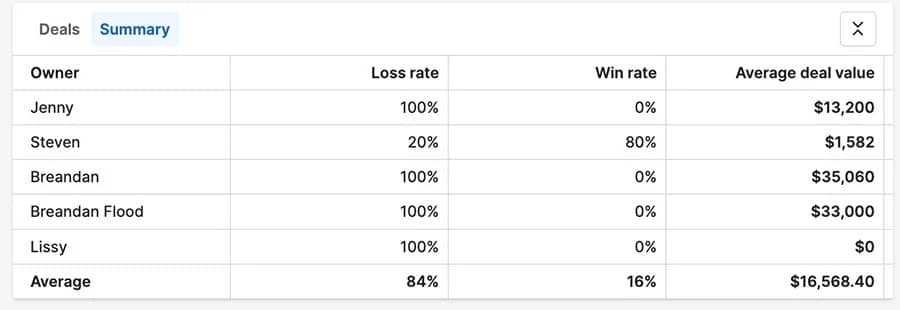
By turning that rep’s process into a quick training module and weekly call review sessions, they lift the entire team’s performance within a quarter.
Here’s how to train and coach your team effectively as a sales leader:
Make sure each rep knows what great performance looks like, and keep them updated on new products or version releases
Review sales call recordings to highlight wins, spot missteps and reinforce best practices
Create short training sessions and focus on one sales skill at a time (e.g., objection handling or demo delivery)
Have top performers share what’s working in short team huddles or playbooks
Arrange guest speakers or webinars with enablement leaders and offer sales courses for certifications
Use your CRM to monitor close rates, time-to-close and follow-up activity
Sales coaching isn’t just for big companies. Even short, focused sessions can help SMB reps level up fast.
Your team stays sharp and confident when training becomes part of your weekly rhythm.
How to hire a sales enablement manager
A sales enablement manager bridges the gap between sales, marketing and operations. They ensure reps have the right content, tools, training and data to sell effectively and consistently.
When your company is growing fast, processes can get messy. A strong hire brings structure to your sales enablement team and can improve rep performance.
A manager’s role and responsibilities will differ depending on the size of your company and the team’s requirements. Before posting a job listing, map out your current enablement needs and future goals.
When hiring, look for someone who can confidently take on tasks like:
Sourcing and storing content creation from marketing, customer success and sales operations
Acting as a bridge between the sales organization, different departments and stakeholders
Understanding how assets fit into the sales team’s funnel and pinpointing content to fill gaps
Implementing new sales enablement platforms, coaching initiatives and processes
Tracking and analyzing which resources and assets are most effective in the sales enablement program
An ideal candidate for most brands will have a strong sales background and excellent communication skills. They’ll also be comfortable researching and implementing cross-departmental strategies.
To determine whether a candidate has the right experience, ask questions like:
“Has there been a time when you improved rep performance through content or training?”
“How have you helped align sales and marketing efforts in previous roles?”
“What metrics do you track to measure the success of a sales enablement program?”
Finally, compensation can vary based on experience and company size, so budget for the right hire.
A typical sales enablement leader’s salary is around $95,000 a year, while senior managers make an average of $130,000 annually.
Final thoughts
A structured sales enablement strategy aligns your teams, builds credibility and lets customer stories convince prospects that your product will work for them.
Investing in the right platform is crucial to track every new initiative’s impact.
Try Pipedrive free for 14 days to streamline your sales process and give your reps the support they need to close more deals.







